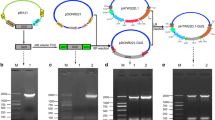Abstract
Four Nicotiana plumbaginifolia mutants exhibiting long hypocotyls and chlorotic cotyledons under white light, have been isolated from M2 seeds following mutagenesis with ethyl methane sulphonate. In each of these mutants, this partly etiolated in white light (pew) phenotype is due to a recessive nuclear mutation at a single locus. Complementation analysis indicates that three mutants, dap5, ems28 and ems3-6-34, belong to a single complementation group called pew1, while dap1 defines the pew2 locus. The mutants at pew1 contain normal levels of immunochemically detectable apoprotein of the phytochrome that is relatively abundant in etiolated seedlings, but are deficient in spectrophotometrically detectable phytochrome, whether seedlings are grown in darkness or light. Moreover, biliverdin, a precursor of the phytochrome chromophore, restores light-regulated responses in pew1 mutants and increases their level of photoreversible phytochrome when grown in darkness. These results indicate that the pew1 locus may be involved in chromophore biosynthesis. The mutant at the pew2 locus displays no photoreversible phytochrome in etiolated seedlings, but does contain normal levels of photoreversible phytochrome when grown in the light. Biliverdin had little effect on light-regulated responses in this mutant. In addition, biliverdin did not alter the level of phytochrome in etiolated seedlings. These observations lead us to propose that this mutant could be affected in the phyA gene itself. We have also obtained the homozygous double mutant at the pew1 and pew2 loci. This double mutant is lethal at an early stage of development, consistent with a critical role for phytochrome in early development of higher plants.
Similar content being viewed by others
References
Adamse P, Jasper PAPM, Kendrick RE, Koornneef M (1987) Photomorphogenetic responses of long hypocotyl mutant of Cucumis sativus L. J Plant Physiol 127:481–491
Bitoun R, Rousselin P, Caboche M (1990) A pleiotropic mutation results in cross-resistance to auxin, abscissic acid and paclobutrazol. Mol Gen Genet 220:234–239
Bourgin J-P, Chupeau Y, Missonier C (1979) Plant regeneration from mesophyll protoplasts of several Nicotiana species. Physiol Plant 45:288–292
Childs KL, Cordonnier-Pratt M-M, Pratt LH, Morgan PW (1992) Genetic regulation of development in Sorghum bicolor. VII. mar 3 flowering mutant lacks a phytochrome that predominates in green tissue. Plant Physiol 99:765–770
Chory J (1993) Out of darkness: mutants reveal pathways controlling light-regulated development in plants. Trends Genet 9:167–172
Chory J, Peto C, Ashbaugh M, Saganich R, Pratt LH, Ausubel F (1989) Different roles for phytochrome in etiolated and green plants deduced from characterization of Arabidopsis thaliana mutants. Plant Cell 1:867–880
Cope M (1991) Comparative analysis of the intracellular redistribution of phytochrome in etiolated soybean seedlings. Thesis, University of Georgia, Athens, USA
Devlin PF, Rood SB, Somers DE, Quail PH, Whitelam GC (1992) Photophysiology of the elongated internode (ein) mutant of Brassica rapa: ein mutant lacks a detectable phytochrome B-like polypeptide. Plant Physiol 100:1442–1447
Elich TD, Mac Donagh AF, Palma LA, Lagarias JC (1989) Phytochrome chromophore biosynthesis: treatment of tetrapyrroledeficient Avena explants with natural and non-natural bilatrienes leads to formation of spectrally active holoproteins. J Biol Chem 264:183–189
Furuya M (1993) Phytochromes: their molecular species, gene families, and functions. Annu Rev Plant Physiol Plant Mol Biol 44:617–645
Gabard J, Marion-Poll A, Cherel I, Meyer C, Muller A, Caboche M (1987) Isolation and characterization of Nicotiana plumbaginifolia nitrate reductase-deficient mutants: genetic and biochemical analysis of the NIA complementation group. Mol Gen Genet 209:596–606
Jabben M, Deitzer G (1978) A method for measuring phytochrome in plants grown in white light. Photochem Photobiol 27:799–802
Kendrick RE, Nagatani A (1991) Phytochrome mutants. Plant J 1:133–139
Koornneef M, Rolff E, Spruit CJP (1980) Genetic control of light-inhibited hypocotyl elongation in Arabidopsis thaliana L. Heynh Z Pflanzenphysiol 100:147–160
Koornneef M, Cone JW, Dekens RG, O'Herne-Robers EG, Spruit CJP, Kendrick RE (1985) Photomorphogenetic responses of long hypocotyl mutants of tomato. J Plant Physiol 120:153–165
Liscum E, Hangarter RP (1991) Arabidopsis mutants lacking blue light-dependent inhibition of hypocotyl elongation. Plant Cell 3:685–694
Lopez-Juez E, Nagatani A, Tomizawa KI, Deak M, Kern R, Kendrick RE, Furuya M (1992) The cucumber long hypocotyl mutant lacks a light-stable PHYB-like phytochrome. Plant Cell 4:241–251
Nagatani A, Reed JW, Chory J (1993) Isolation and initial characterization of Arabidopsis mutants that are deficient in phytochrome A. Plant Physiol. 102:269–277
Parks BM, Quail PH (1991) Phytochrome-deficient hyl and hy2 long hypocotyl mutants of Arabidopsis are defective in phytochrome chromophore biosynthesis. Plant Cell 3:1177–1186
Parks BM, Quail PH (1993) hy8, a new class of Arabidopsis long hypocotyl mutants deficient in functional phytochrome A. Plant Cell 5:39–48
Parks BM, Shanklin J, Koornneef M, Kendrick RE, Quail PH (1989) Immunochemically detectable phytochrome is present at normal levels but is photochemically nonfunctional in the hyl and hy2 long hypocotyl mutants of Arabidopsis. Plant Mol Biol 12:425–437
Pratt L, Wampler J, Rich E (1985) An automated dual-wavelength spectrophotometer optimized for phytochrome assay. Anal Instrument 13:269–287
Pratt LH, McCurdy DW, Shimazaki Y, Cordonnier M-M (1986) Immunodetection of phytochrome: Immunocytochemistry, immunoblotting and immunoquantitation. In: Linskens HF, Jackson JF (eds) Modern methods of plant analysis, New Ser vol 4. Springer, Berlin Heidelberg New York, pp 50–74
Quail PH (1991) Phytochrome: A light activated molecular switch that regulates plant gene expression. Annu Rev Genet 25:389–409
Reed JW, Nagpal P, Chory J (1992) Searching for phytochrome mutants. Photochem Photobiol 56:833–838
Reed JW, Nagpal P, Poole DS, Furuya M, Chory J (1993) Mutations in the gene for red/far-red light receptor phytochrome B alter cell elongation and physiological responses throughout Arabidopsis development. Plant Cell 5:147–157
Wang YC, Stewart SJ, Cordonnier M-M, Pratt LH (1991) Avena sativa L. contains three phytochromes, only one of which is abundant in etiolated tissue. Planta 184:96–104
Author information
Authors and Affiliations
Additional information
Communicated by A. Kondorosi
Rights and permissions
About this article
Cite this article
Kraepiel, Y., Jullien, M., Cordonnier-Pratt, MM. et al. Identification of two loci involved in phytochrome expression in Nicotiana plumbaginifolia and lethality of the corresponding double mutant. Molec. Gen. Genet. 242, 559–565 (1994). https://doi.org/10.1007/BF00285279
Received:
Accepted:
Issue Date:
DOI: https://doi.org/10.1007/BF00285279




